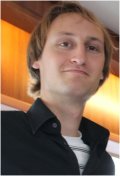 In this thesis Germanium-Silicon (Ge-Si) core-shell nanowires are investigated, as a possible candidate for spin qubits and Majorana qubits. Quantum computers work in a fundamentally different way than classical computers do. These employ quantum mechanical bits, or qubits, as their smallest building blocks.
In this thesis Germanium-Silicon (Ge-Si) core-shell nanowires are investigated, as a possible candidate for spin qubits and Majorana qubits. Quantum computers work in a fundamentally different way than classical computers do. These employ quantum mechanical bits, or qubits, as their smallest building blocks.
‘Qubits have been realized in a large variety of systems already, but it is yet unclear which type will be used for the first universal quantum computer,’ Joost Ridderbos positions his PhD research.
As a member of the Nano Electronics Group, at the start of his project, he collaborated with a colleague PhD on this same subject. ‘By sparring, learning and jointly performing experiments, we progressed more than twice as fast,’ he says.
Joost successfully characterized the quality of the nanowires, determining the hole mobility, with a wide variety of nanowire diameters. ‘An early conclusion was the importance to select and fabricate small diameter Ge-Si nanowires for further experiments,’ Joost says.
Ge-Si nanowires are hole conductors, and are an important candidate for spin-orbit qubits.
Holes are localized in the Ge-core of the nanowires, and are further confined by a set of perpendicular gates, in order to create quantum dots.
‘Next to this type of qubit, we used superconducting contacts to the nanowires, in order to study their feasibility for Majorana fermions’, Joost says. ‘Here, a Josephson current is induced in the nanowire. We investigated the effects of the charge occupancy, magnetic field, microwave field and temperature.’
Promising
Ge-Si nanowires exhibit many highly promising properties. ‘To fabricate quantum dot devices, we deposited nanowires on pre-fabricated bottom-gates,’ Joost says. ‘From there we demonstrated the ability to make highly tunable quantum dots of varying lengths between 60 nm and 460 nm, determined by the pitch of our gate design.’
With excited state magneto-spectroscopy and measuring the resulting Zeeman splitting, the so-called g-factor as a function of field direction, could be mapped. It was found to depend not only on the magnetic, but also on the electric field, produced by the gates.
‘This feature can be utilized to in-situ tune the resonance frequency of holes, in specific quantum dots. This makes them separately addressable when rotating their spins,’ Joost says. ‘This is an important step for quantum computation applications.’
‘To create an actual qubit we must experimentally demonstrate full spin control in these devices. A first step has been taken, by initializing the hole spin in a very stable double quantum dot.’
Superconducting phase
Further, by using aluminium as superconducting contacts, a Josephson current could be induced in Ge-Si nanowires.
Joost: ‘A magnetospectroscopy of the Josephson junction reveals a second superconducting phase being present inside, or in close proximity to, the nanowire. When combined with the other promising properties of these nanowires, this specific superconducting alloy can be interesting for applications requiring the combination of superconductivity with high magnetic fields, such as Majorana fermions.’
Joost concludes that his results - for both the normal-state quantum dot devices and the superconducting devices - illustrate the versatility and suitability of Ge-Si nanowires for quantum computation applications.
Experiments
‘During the PhD project, you get to know yourself by pushing your boundaries,’ Joost says. ‘Designing, building and performing experiments in an independent way, was very challenging. I was happy to use the great equipment from the Nanolab, and take advantage of the vast expert knowledge available.’
‘The preparations before actual experiments can be performed, take detailed attention and time,’ he says. ‘I am happy, as a spin-off from my work, now better scripts are available for the Group, to push e-beam lithography apparatus to the limit. Next generation PhD’s and researchers may now perform high-quality and reproducible measurements of lithographic resolutions and alignment precisions down to 10-20 nm.’
Future plans
After his PhD Defence Joost prefers a post-doc position. ‘My first orientation is on Western Europe,’ he says. ‘In, for instance, Copenhagen, Vienna and Basel, interesting Groups are present to further work on my academic skills. I love to perform research and being able to pose fundamental questions to be investigated. I enjoyed growing on this research topic and become an expert. It is a privilege to collaborate with colleagues to expand physical knowledge.’
